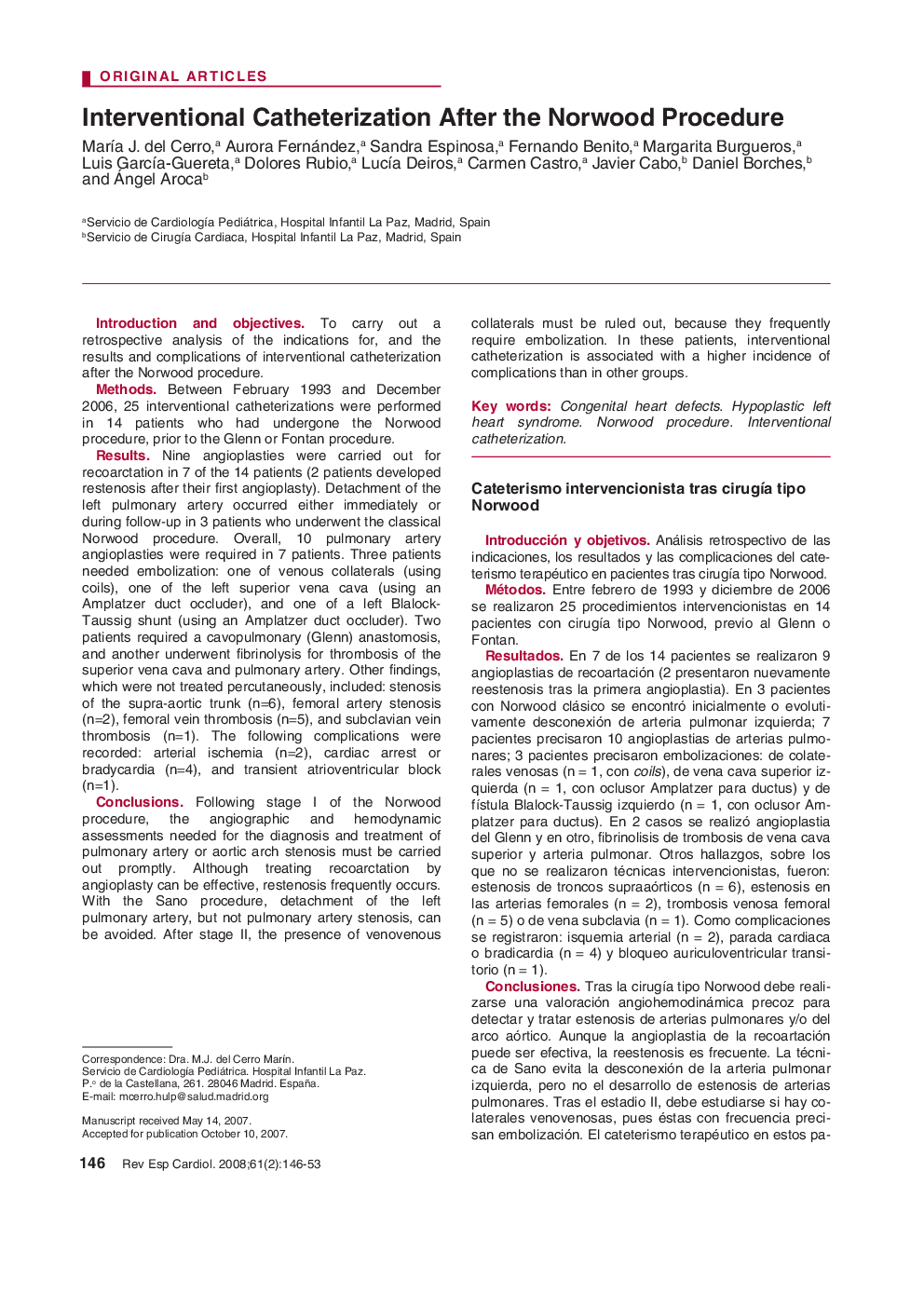| Article ID | Journal | Published Year | Pages | File Type |
|---|---|---|---|---|
| 3018961 | Revista Española de Cardiología (English Edition) | 2008 | 8 Pages |
Introduction and objectivesTo carry out a retrospective analysis of the indications for, and the results and complications of interventional catheterization after the Norwood procedure.MethodsBetween February 1993 and December 2006, 25 interventional catheterizations were performed in 14 patients who had undergone the Norwood procedure, prior to the Glenn or Fontan procedure.ResultsNine angioplasties were carried out for recoarctation in 7 of the 14 patients (2 patients developed restenosis after their first angioplasty). Detachment of the left pulmonary artery occurred either immediately or during follow-up in 3 patients who underwent the classical Norwood procedure. Overall, 10 pulmonary artery angioplasties were required in 7 patients. Three patients needed embolization: one of venous collaterals (using coils), one of the left superior vena cava (using an Amplatzer duct occluder), and one of a left Blalock-Taussig shunt (using an Amplatzer duct occluder). Two patients required a cavopulmonary (Glenn) anastomosis, and another underwent fibrinolysis for thrombosis of the superior vena cava and pulmonary artery. Other findings, which were not treated percutaneously, included: stenosis of the supra-aortic trunk (n=6), femoral artery stenosis (n=2), femoral vein thrombosis (n=5), and subclavian vein thrombosis (n=1). The following complications were recorded: arterial ischemia (n=2), cardiac arrest or bradycardia (n=4), and transient atrioventricular block (n=1).ConclusionsFollowing stage I of the Norwood procedure, the angiographic and hemodynamic assessments needed for the diagnosis and treatment of pulmonary artery or aortic arch stenosis must be carried out promptly. Although treating recoarctation by angioplasty can be effective, restenosis frequently occurs. With the Sano procedure, detachment of the left pulmonary artery, but not pulmonary artery stenosis, can be avoided. After stage II, the presence of venovenous xscollaterals must be ruled out, because they frequently require embolization. In these patients, interventional catheterization is associated with a higher incidence of complications than in other groups.
Introducción y objetivosAnálisis retrospectivo de las indicaciones, los resultados y las complicaciones del cate-terismo terapéutico en pacientes tras cirugía tipo Norwood.MétodosEntre febrero de 1993 y diciembre de 2006 se realizaron 25 procedimientos intervencionistas en 14 pacientes con cirugía tipo Norwood, previo al Glenn o Fontan.ResultadosEn 7 de los 14 pacientes se realizaron 9 angioplastias de recoartación (2 presentaron nuevamente reestenosis tras la primera angioplastia). En 3 pacientes con Norwood clásico se encontró inicialmente o evoluti-vamente desconexión de arteria pulmonar izquierda; 7 pacientes precisaron 10 angioplastias de arterias pulmo-nares; 3 pacientes precisaron embolizaciones: de colate-rales venosas (n = 1, con coils), de vena cava superior iz-quierda (n = 1, con oclusor Amplatzer para ductus) y de fístula Blalock-Taussig izquierdo (n = 1, con oclusor Am-platzer para ductus). En 2 casos se realizó angioplastia del Glenn y en otro, fibrinolisis de trombosis de vena cava superior y arteria pulmonar. Otros hallazgos, sobre los que no se realizaron técnicas intervencionistas, fueron: estenosis de troncos supraaórticos (n = 6), estenosis en las arterias femorales (n = 2), trombosis venosa femoral (n = 5) o de vena subclavia (n = 1). Como complicaciones se registraron: isquemia arterial (n = 2), parada cardiaca o bradicardia (n = 4) y bloqueo auriculoventricular transitorio (n = 1).ConclusionesTras la cirugía tipo Norwood debe reali-zarse una valoración angiohemodinámica precoz para detectar y tratar estenosis de arterias pulmonares y/o del arco aórtico. Aunque la angioplastia de la recoartación puede ser efectiva, la reestenosis es frecuente. La técni-ca de Sano evita la desconexión de la arteria pulmonar izquierda, pero no el desarrollo de estenosis de arterias pulmonares. Tras el estadio II, debe estudiarse si hay co-laterales venovenosas, pues éstas con frecuencia preci-san embolización. El cateterismo terapéutico en estos pa-cientes comporta una incidencia de complicaciones mayor que en otros grupos de pacientes.
